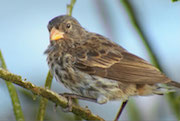More About Intracellular Infection By Salmonella
There are many strains of Salmonella; nearly all are potentially pathogenic. The most severe illness caused by a Salmonella strain is typhoid fever, which is caused by S. typhi. Less severe forms of
Part 1: A bacterium induces the host intestinal cell to engulf it
Salmonella has a dramatic way of invading the host cell. The surface of intestinal cells is covered with microvilli, finger-shaped extensions of the cell that vastly increase the surface area for absorbing nutrients. The animation starts with a Salmonella swimming up to the intestinal cell's surface membrane. Like the enteropathogenic E. coli shown in a companion animation, it uses a specialized syringelike mechanism (called Type III injector system) to inject proteins through the host membrane surface and into the cytoplasm. The injected proteins trigger the epithelial cell membrane to extend outward (ruffle), and they also rearrange the cytoskeleton of the host cell. As a result, the bacterium is engulfed and dragged inside the host cell.
Part 2: The bacterium eludes the host cell's intracellular defense mechanism and multiplies
The view now shifts to the interior of the host cell. You can see a tangled mat of the host actin filaments, part of the host cell's cytoskeleton. The process of engulfing the bacterium (invasion) ends up with the bacterium completely encased in a vacuole made up of the host cell membrane. The vacuole is dragged inside the cell by actin filaments. This process is somewhat similar in appearance to phagocytosis, one of the basic cellular mechanisms of ingestion leading to digestion.
Under normal circumstances, the host cell has the bacterium exactly
where it wants it. The normal mechanism for dealing with a foreign body
invading a cell involves lysosomes of the cell fusing with the vacuole
surrounding the invader and showering it with a concentrated mix of
A Type III injector system is used to inject other bacterial proteins
into the surrounding vacuole and adjacent area. This second injection
alters the vacuole structure is altered (shown as a white-blue glow in
the animation). The vacuole is now blocked from fusion with toxic
lysosomes (shown as red balls). Now safe and sound, Salmonella begins to divide inside the vacuole. The vacuole itself
Intracellular Infection by Salmonella Animation Background
Bacteria are small, single-celled organisms whose genetic material is
not enclosed in a special nuclear membrane. For this reason, bacteria
are called procaryotes (meaning prenucleus). Most bacteria can live
inside the human body without causing any
Some types of bacteria, such as Salmonella and Listeria, live inside human cells. They are called intracellular pathogens. The ability of intracellular pathogens to hide inside the host cells shields them from the immune system. Intracellular pathogens have developed ways to spread from cell to cell, a process critical to their ability to cause disease.
Salmonella Animation Teaching Tips
The animations in this section have a wide variety of classroom applications. Use the tips below to get started but look for more specific teaching tips in the near future. Please tell us how you are using the animations in your classroom by sending e-mail to biointeractive@hhmi.org.
-
Use the animations to make abstract scientific ideas visible and concrete.
-
Explain important scientific principles through the animations. For example, the biological clocks animations can be used to demonstrate the fundamentals of transcription and translation.
-
Make sure that students learn the material by repeating sections of the animations as often as you think necessary to reinforce underlying scientific principles. You can start, restart, and play back sections of the animations.
-
Urge students to use the animations in accordance with their own learning styles. Students who are more visually oriented can watch the animations first and read the text later, while others might prefer to read the explanations first and then view the graphics.
-
Incorporate the animations into Web-based learning modules that you create to supplement your classroom curricula.
-
Encourage students to incorporate the animations into their own Web-based projects.
Intracellular Infection by Salmonella Credits
Director: Dennis Liu, Ph.D.
Scientific Direction: B. Brett Finlay, Ph.D.
Scientific Content: Satoshi Amagai, Ph.D.
Animators: Eric Keller, Satoshi Amagai, Ph.D.









